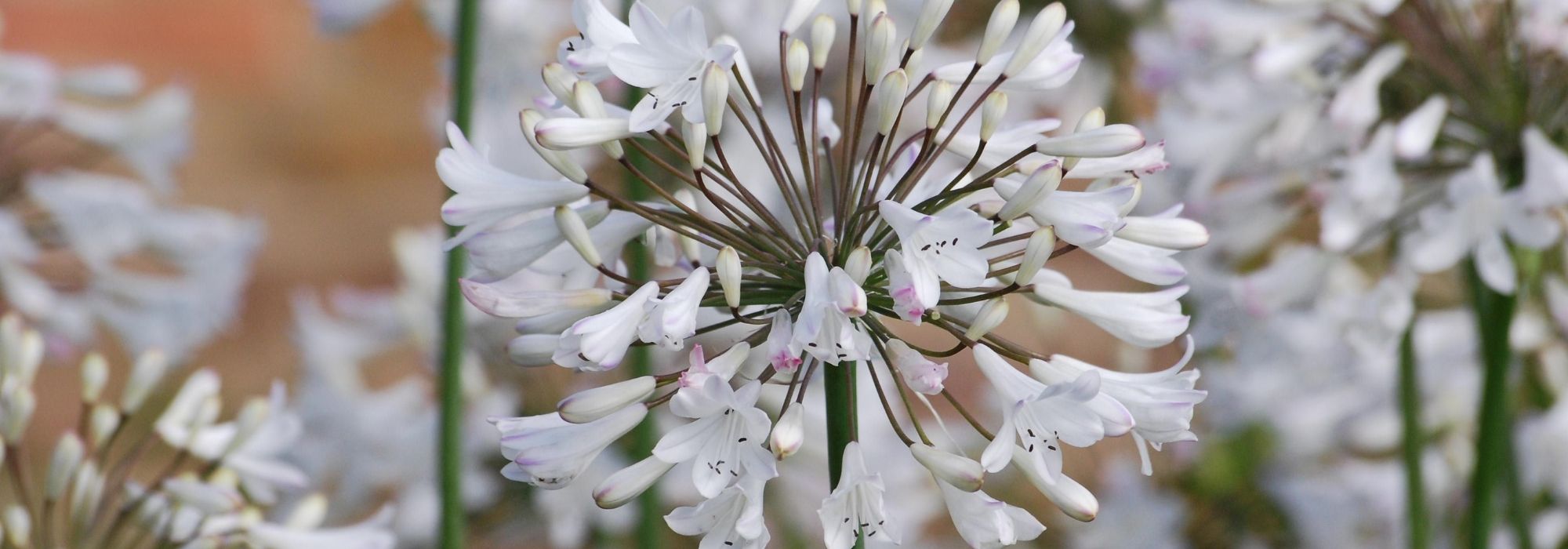
Agapanthus: 6 ideas for successful plant combinations
Plant pairings for every garden style
Summary
Trendy, agapanthas are those magnificent graceful upright blue flowers that bloom all summer. Today, their shades declinate into a multitude of blues, purples and whites. They are particularly suited to dry and sunny mediums and pair wonderfully with many plants.
Formerly reserved for classic seaside gardens, agapanthas now populate all borders, whatever their style.
Discover our 6 ideas to combine agapanthas and create scenes with varied atmospheres — monochrome, natural, contemporary and even exotic. All that’s left is to choose!
Agapanthus in shades of blue
Agapanthus come in a multitude of blues ranging from palest to deepest. The first idea is therefore simply to pair them together. To create a lovely gradient, choose the inimitable pale blue of Agapanthus Tinkerbell or Agapanthus Dokter Brouwer, the bright sky blue of Agapanthus Blue Heaven, the midnight blue of Agapanthus Midnight Blue or the deep navy blue of Agapanthus Navy Blue.

Shades of blue in Agapanthus: the varieties Blue Heaven, Navy Blue and Midnight Blue
Complete this palette of blues with other blue flowerings from plants that enjoy sunny spots, such as:
- Climbing clematis with blue flowers: Clematis Arabella with star-shaped flowers in shades of blue, Clematis Success Lavander with lavender-blue flowering, or Clematis viticella Perle d’azur with a pure azure blue.
- summer flowers of Caryopteris Grand Bleu, perovskias or nepetas.
- varied, intense blues of sages: marsh sage or Salvia ‘Blue Note’.
- upright spikes of lupins, blue larkspurs, or nepetas.

Pair blue flowers: blue delphiniums (Ballkleid, Blue Bird for a darker tone or Summer Skies for example), Clematis Arabella and Caryopteris Grand Bleu
With this blue scene, create calm, soothing garden. Amplify scene with blue garden furniture and blue shutters. Finally, remember blue is ideal in small garden: placed at garden’s far end, it gives impression garden is larger, so make the most of it.
Note that there are hardy Agapanthus (down to -15°C in drained soil), allowing you to enjoy them and include them in most regions.
You may also read
Agapanthus: planting, growing and careAgapanthus and white garden
The white agapanthus are perfect for bringing that wonderful touch of purity, elegance and refinement to a garden. They are particularly at home in a monochrome garden, like the famous white garden at Sissinghurst Castle in Kent. Because white is rarely pure, creating a white garden is not easy, but there’s no need to use many whites. To avoid any discord, pair two or three well-chosen white flowers with green, blue-tinged or silvery foliage, or with grasses such as stipas or fescues…
If space allows, start by planting a Mexican blue palm with superb grey-blue fronds or a Pyrus salicifolia Pendula as a backdrop.
Then, combine a few clumps of Agapanthes africanus Albus with delicate-flowering sages such as Salvia greggii Alba. Add a white lamium as groundcover and a few eryngiums with silvery foliage for summer.
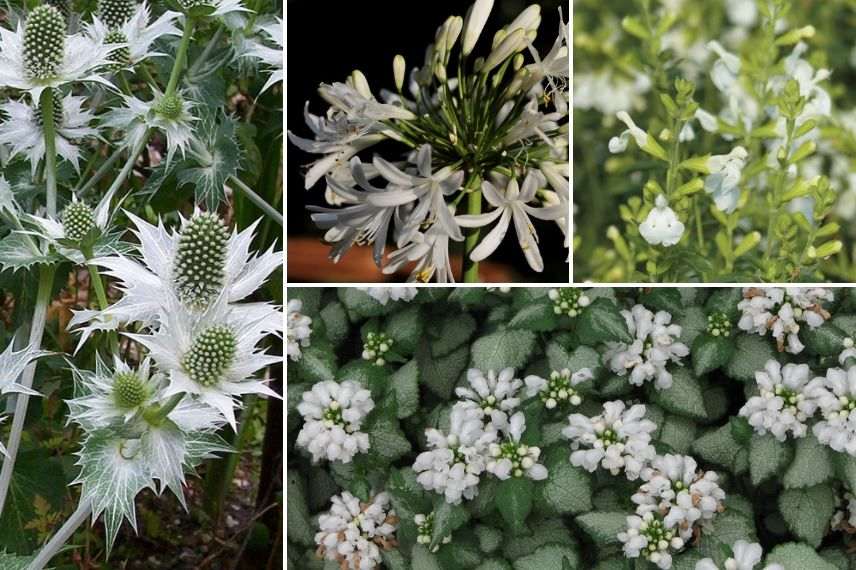
White garden scene featuring Eryngium giganteum, Agapanthe africanus Albus, Salvia greggii Alba and Lamium maculatum White Nancy
Discover other Agapanthus - Lily of the Nile
View All →Available in 0 sizes
Available in 1 sizes
Available in 5 sizes
Available in 2 sizes
Available in 0 sizes
Available in 2 sizes
Available in 3 sizes
Available in 0 sizes
Available in 4 sizes
Available in 0 sizes
Seaside ambience with agapanthus
Spectacular summer flowers of agapanthus are perfect for creating a maritime atmosphere that evokes the seaside.
If you opt for a “midrib west” Atlantic seaboard vibe, pair agapanthus with maritime pines, hydrangeas, monk’s pepper, heather, feather grass, broom and Sedum spectabile. Shades of blue, pink, white, grey and gold are ideal.
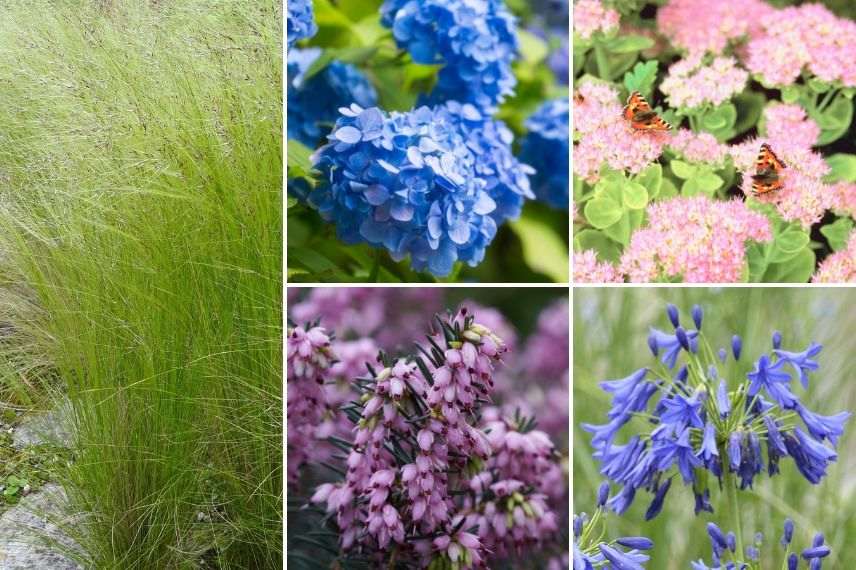
Atlantic seaboard atmosphere with Agapanthe Flower of Love, hydrangeas, sedums, feather grass and heather
If you prefer the Mediterranean coast, choose santolina, Gunn’s eucalyptus, cistus, yucca, germander, Euphorbia characias, cordyline, Italian immortelle, New Zealand flax or simply the essential lavender, thyme and rosemary. They are perfect to accompany olive, Italian cypress or stone pine.
In these scenes, greyer foliage tones dominate but brighter colours also appear, such as yellow, red or even purple.
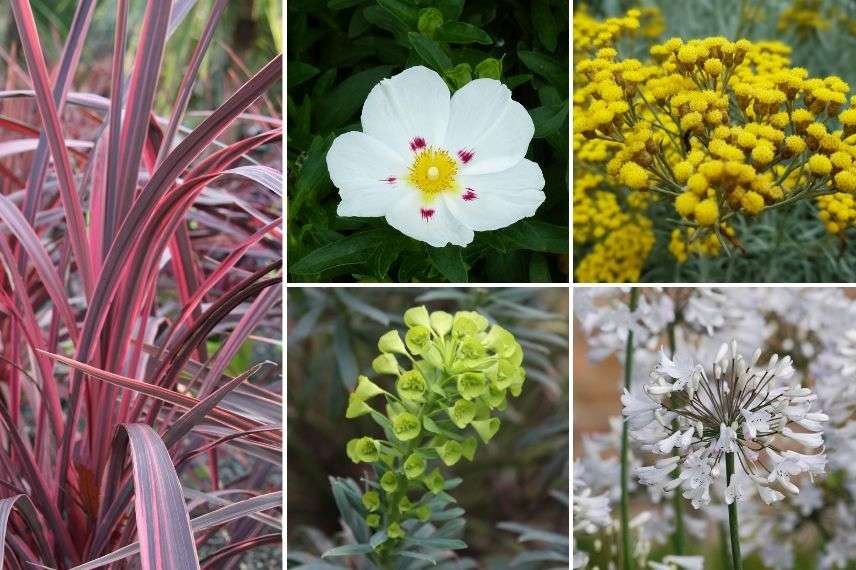
Combination of Cordyline, cistus, Agapanthe Midnigth Blue, Euphorbia characias and Italian immortelle
If you are really by the sea, we have selected a palette of perennial plants resistant to salt spray and seaside conditions.
Natural display featuring agapanthus
Agapanthus, with their graceful, flowing habit, also create a natural ambience in your garden. To achieve this, simply combine them with suitable plants and arrange them randomly, avoiding straight lines, symmetry and geometry. Plant by mixing species together.
For creating this natural ambience, we recommend pairing agapanthus with sun-loving wildflowers such as gaura, Buenos Aires verbena, scabious, echinacea, mulleins or astrantia. Add soft grasses such as stipa, calamagrostis, carex, pennisetum or other eragrostis. Some of these have particularly golden foliage that pairs wonderfully with blue of agapanthus: Deschampsia Tatra Gold or brome Skinner’s Gold. To complete the scene, you can plant shrubby salvias whose flower colours are very varied.
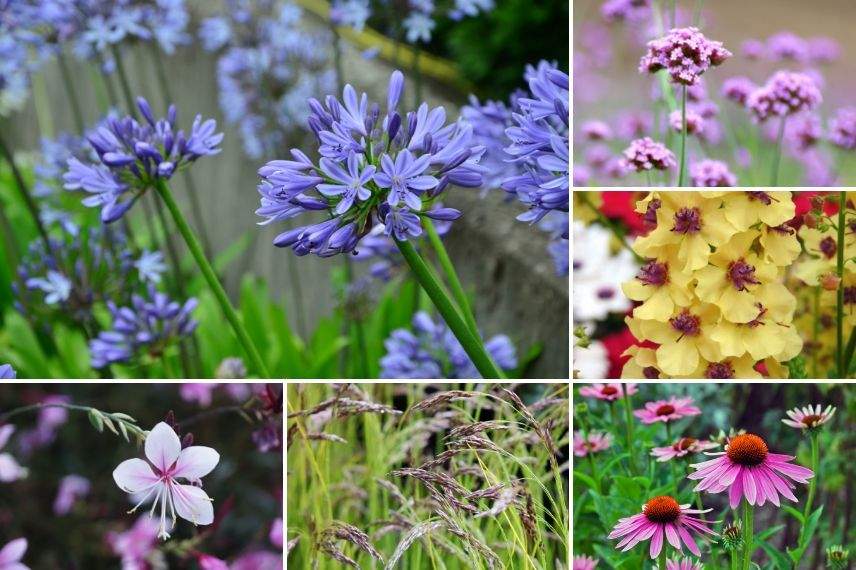
Pair a blue agapanthus with a mix of gaura, Buenos Aires verbena, the golden foliage of Deschampsia Tatra Gold, the pink flowers of echinacea and a yellow-flowering Verbascum such as Cotswold Queen
Contemporary ambience with agapanthus
Very fashionable in gardens, agapanthus are must-haves in contemporary gardens. Paired with geometric shapes and varied materials like wood and stone, they quickly make an impact.
The slender habit of agapanthus contrasts with and complements evergreen bushes pruned into spheres such as osmanthus, shrubby honeysuckle, pittosporum or crenate holly (we do not recommend box spheres as boxwood often suffers from disease or attack by box tree moth).
Contemporary pairings are accompanied by trendy flowing grasses such as feather grass and blue fescues.
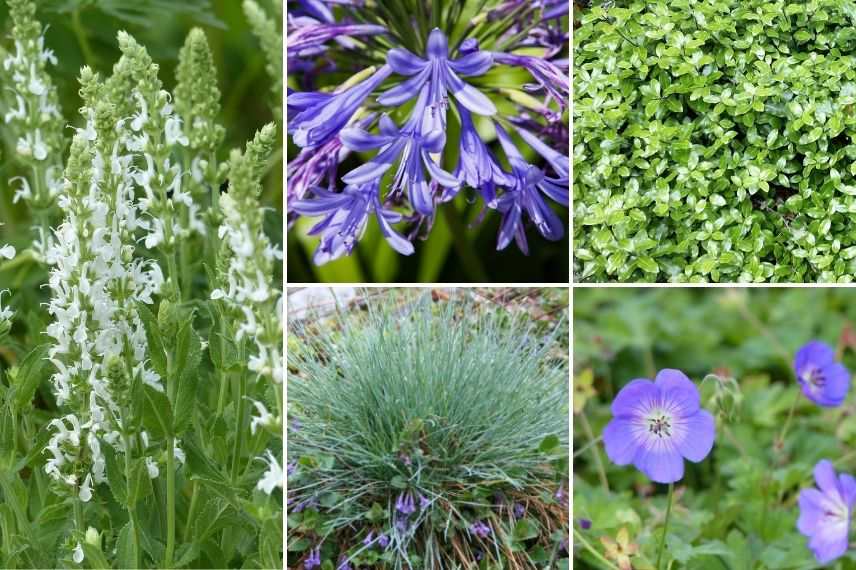
An example of a pairing with blue agapanthus with spikes of Salvia nemorosa Schneehügel, with blue fescue, with Geranium Azure Rush and with Pittosporum ‘Golf Ball’ pruned into spheres
Silvery leaf tones such as those of santolinas, perovskias, artemisias or sages would also blend perfectly into the composition. Opt, in that case, for cushion forms for santolinas and common sage and prefer the looser, more natural forms of artemisias and perovskias. Contemporary garden is a subtle mix of geometric shapes and airy forms.
An exotic border with agapanthus
Agapanthus’s exotic touch can easily be enhanced to create a particularly tropical scene. To do this, pair the blue of agapanthus with the orange often associated with exotic scenes. Blue and orange being complementary colours, they harmonise very well together.
For orange flowers, choose plants that thrive in full sun such as cannas, kniphofias, daylilies, crocosmias, bird of paradise and clivias.
Other exotic flowers also combine very well, such as scented Abyssinian gladioli. To complete the tropical picture, pair these flowers with bushes or tall plants such as yucca, cordyline, dwarf palm, grevillea, bottlebrush, banana tree, aralia or New Zealand flax.
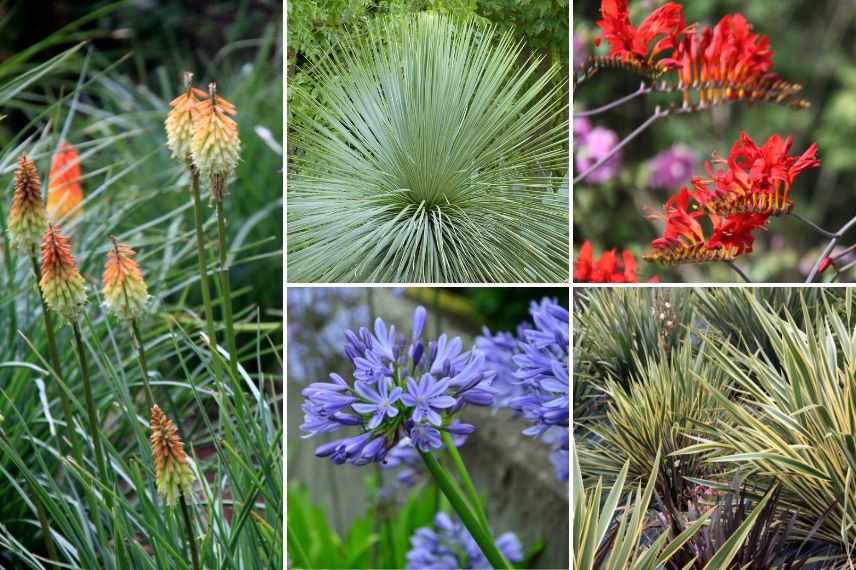
An example of an exotic scene: Kniphofia, Yucca rostrata, Crocosmia Lucifer, Blue agapanthus and Phormium
- Subscribe!
- Contents
































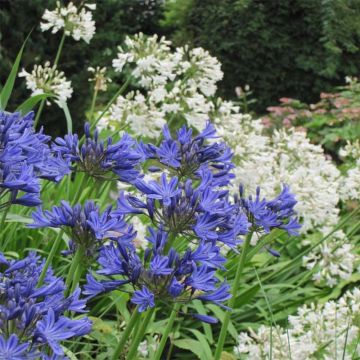

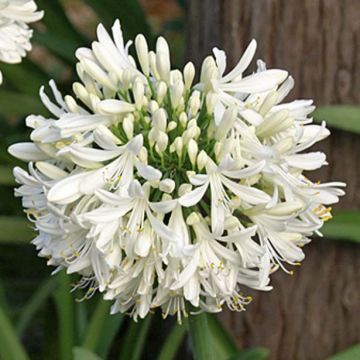
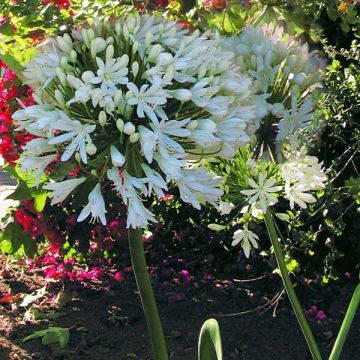
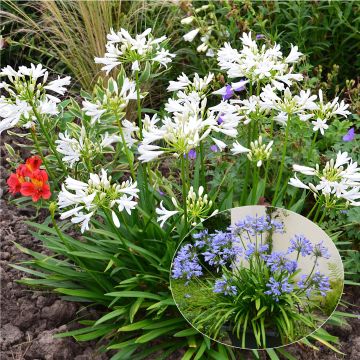
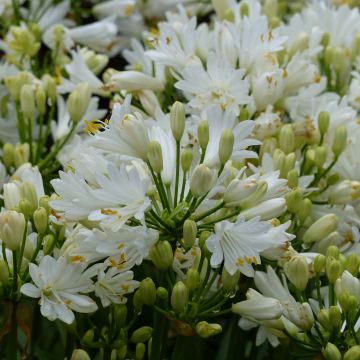

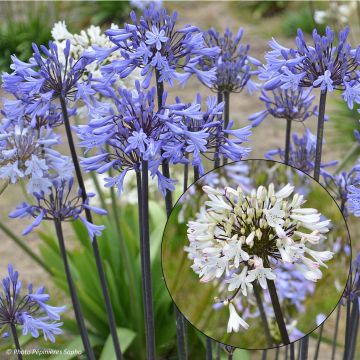
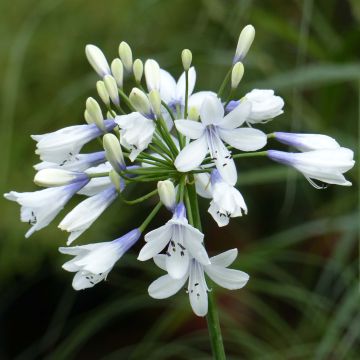
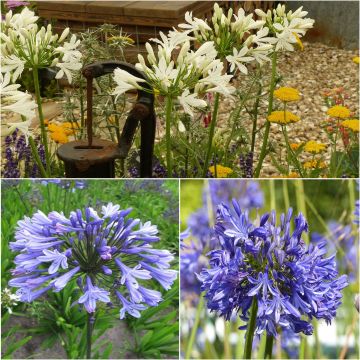
Feedbacks